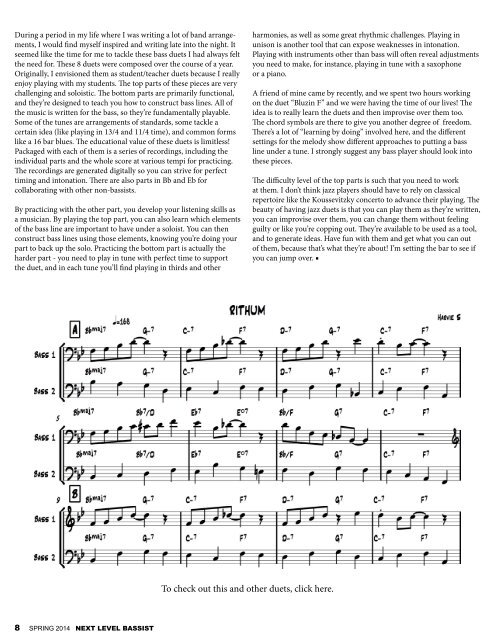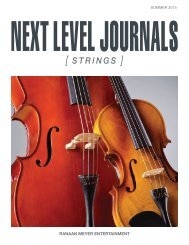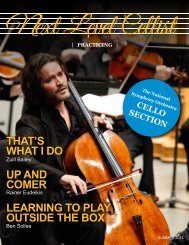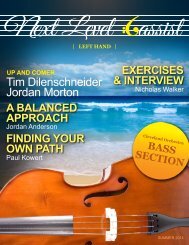Next Level Bassist Teaching and Inspiration
You also want an ePaper? Increase the reach of your titles
YUMPU automatically turns print PDFs into web optimized ePapers that Google loves.
During a period in my life where I was writing a lot of b<strong>and</strong> arrangements,<br />
I would find myself inspired <strong>and</strong> writing late into the night. It<br />
seemed like the time for me to tackle these bass duets I had always felt<br />
the need for. These 8 duets were composed over the course of a year.<br />
Originally, I envisioned them as student/teacher duets because I really<br />
enjoy playing with my students. The top parts of these pieces are very<br />
challenging <strong>and</strong> soloistic. The bottom parts are primarily functional,<br />
<strong>and</strong> they’re designed to teach you how to construct bass lines. All of<br />
the music is written for the bass, so they’re fundamentally playable.<br />
Some of the tunes are arrangements of st<strong>and</strong>ards, some tackle a<br />
certain idea (like playing in 13/4 <strong>and</strong> 11/4 time), <strong>and</strong> common forms<br />
like a 16 bar blues. The educational value of these duets is limitless!<br />
Packaged with each of them is a series of recordings, including the<br />
individual parts <strong>and</strong> the whole score at various tempi for practicing.<br />
The recordings are generated digitally so you can strive for perfect<br />
timing <strong>and</strong> intonation. There are also parts in Bb <strong>and</strong> Eb for<br />
collaborating with other non-bassists.<br />
By practicing with the other part, you develop your listening skills as<br />
a musician. By playing the top part, you can also learn which elements<br />
of the bass line are important to have under a soloist. You can then<br />
construct bass lines using those elements, knowing you’re doing your<br />
part to back up the solo. Practicing the bottom part is actually the<br />
harder part - you need to play in tune with perfect time to support<br />
the duet, <strong>and</strong> in each tune you’ll find playing in thirds <strong>and</strong> other<br />
harmonies, as well as some great rhythmic challenges. Playing in<br />
unison is another tool that can expose weaknesses in intonation.<br />
Playing with instruments other than bass will often reveal adjustments<br />
you need to make, for instance, playing in tune with a saxophone<br />
or a piano.<br />
A friend of mine came by recently, <strong>and</strong> we spent two hours working<br />
on the duet “Bluzin F” <strong>and</strong> we were having the time of our lives! The<br />
idea is to really learn the duets <strong>and</strong> then improvise over them too.<br />
The chord symbols are there to give you another degree of freedom.<br />
There’s a lot of “learning by doing” involved here, <strong>and</strong> the different<br />
settings for the melody show different approaches to putting a bass<br />
line under a tune. I strongly suggest any bass player should look into<br />
these pieces.<br />
The difficulty level of the top parts is such that you need to work<br />
at them. I don’t think jazz players should have to rely on classical<br />
repertoire like the Koussevitzky concerto to advance their playing. The<br />
beauty of having jazz duets is that you can play them as they’re written,<br />
you can improvise over them, you can change them without feeling<br />
guilty or like you’re copping out. They’re available to be used as a tool,<br />
<strong>and</strong> to generate ideas. Have fun with them <strong>and</strong> get what you can out<br />
of them, because that’s what they’re about! I’m setting the bar to see if<br />
you can jump over. ■<br />
To check out this <strong>and</strong> other duets, click here.<br />
8 SPRING 2014 NEXT LEVEL BASSIST
















